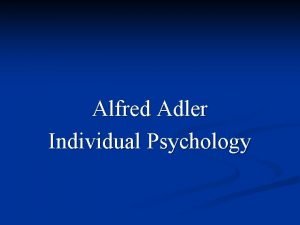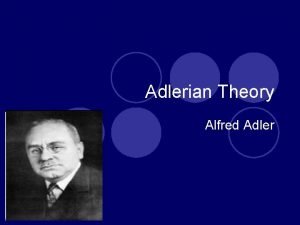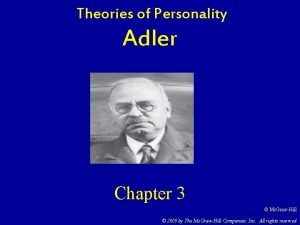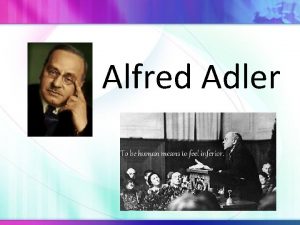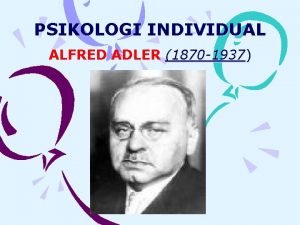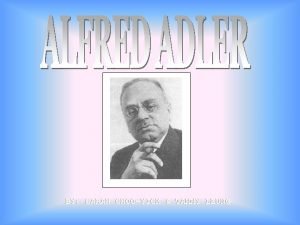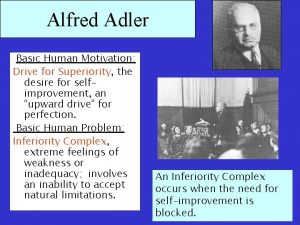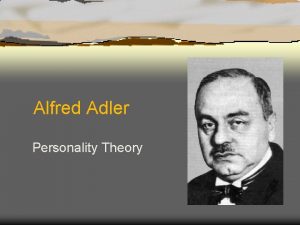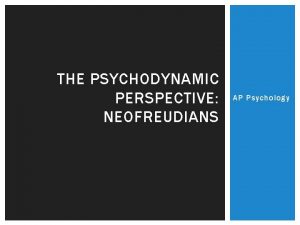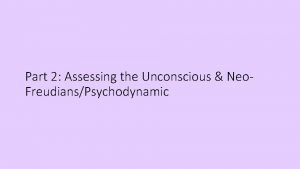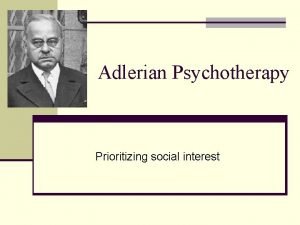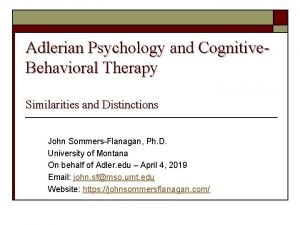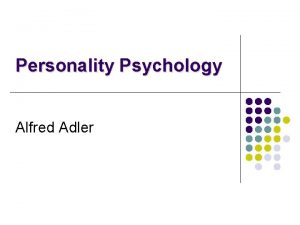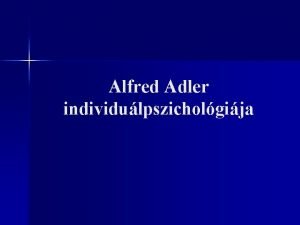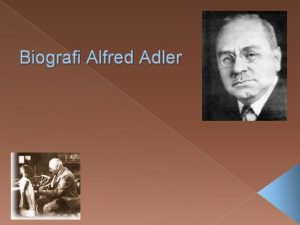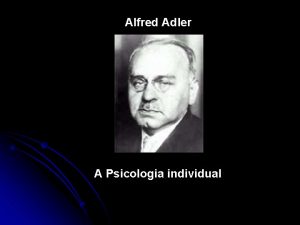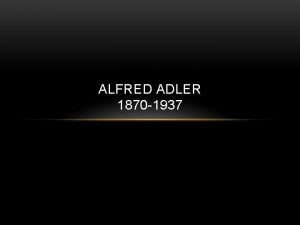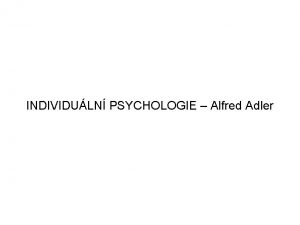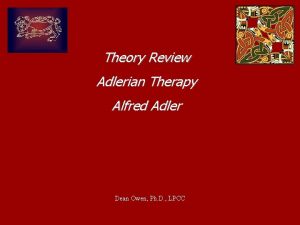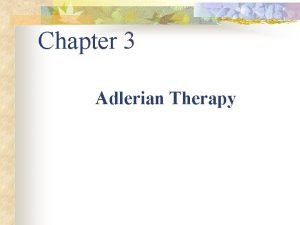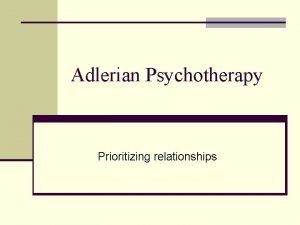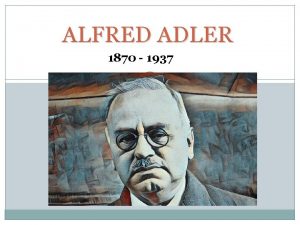Adlerian Theory Alfred Adler Theory of personality l















- Slides: 15

Adlerian Theory Alfred Adler

Theory of personality l Consciousness more important than unconsciousness ¡ l The person is viewed holistically— we are creative, responsible, becoming ¡ l Interpersonal psychology rather than intrapersonal psychology People are not “pushed” by heredity and environment as much as “pulled” by the future… ¡ l Contrasts with Freud’s more pessimistic view of human nature and portrayal of personality as comprised of parts Social being is emphasized ¡ l Ego more important than id. The person’s past and circumstances “frame” and “influence” the individual’s goals Life is a dynamic striving for: ¡ ¡ ¡ Security Self-esteem A place of Significance in the world

Theory of personality l Striving for superiority (Feelings of inferiority) ¡ Born helpless and dependent l l Impetus of personality development – The Style of Life Social Interest Individual’s attitude toward and awareness of being a part of the human community ¡ Healthy personality related to the degree to which we successfully share with others and are concerned with their welfare ¡ l ¡ connectedness Three universal life tasks l l l ¡ Happiness and success are largely related to social Building friendships Establishing intimacy Contributing to society Birth Order l Ordinal position predicts some degree of style of life

The creative self l The concepts involved in the development of the style of life manifest through the CREATIVE SELF ¡ l Objective facts translated into personally meaningful events The creative self drives the individual to negotiate the BASIC LIFE TASKS ¡ ¡ ¡ Work Opposite sex relationships Being a constructive part of society

Inferiority and compensation l As children search for significance, they draw conclusions about the self> l 4 goals of the “discouraged child” ¡ ATTENTION GETTING ¡ POWER SEEKING ¡ REVENGE TAKING ¡ DECLARING DEFICIENCY OR DEFEAT

The discouraged child l All of the 4 goals identified by Dreikurs can be portrayed by any child, discouraged or otherwise. It is a matter of degree, frequency, and whether or not the child has an underlying sense of hopefulness, acceptance and significance that determines the health of the child.

Psychopathology l Two problems drive psychopathology ¡ ¡ Exaggerated inferiority feeling Insufficiently developed feeling of community l Manifest through pathological lifestyles l Pampered lifestyle ¡ l Compulsive lifestyle ¡ l Parental overindulgence Parental domination Other manifestations ¡ ¡ Abuse Neglect

Psychopathology - Basic mistakes l OVERGENERALIZATIONS l FALSE OR IMPOSSIBLE GOALS OF SECURITY l MISPERCEPTIONS OF LIFE AND LIFE’S DEMANDS l MIMIMIZATION OF ONE’S WORTH l FAULTY VALUES Thought: This is a short list but a valuable one; many psychological problems that people have can be explained by these 5 “basic mistakes”.

Goals of Therapy l Educate clients about psychological processes l Educate clients about “basic mistakes” l Release or encourage clients’ social interest l Encourage clients to recognize their equality

Therapeutic Relationship l Prototype of social interest ¡ l Therapist’s Role ¡ ¡ l Love, faith and hope for the human condition Psychoeducator/role-model Cooperative Egalitarian Authentic, caring, and genuine Client ¡ Active learner taking social interest within the session

Adlerian Therapeutic Techniques l Analysis ¡ l Interpretation geared toward increasing the perception of purposive nature of life The Life Style Investigation/Feedback ¡ ¡ Family constellation Earliest Recollections Catching oneself – Contingency control l Acting “As If” – Choosing/reevaluation l Push button technique – Precursor to cognitive interventions. Change through choosing l

Content l Intrapersonal conflict important, but marked a distinct move toward dealing with interpersonal conflict l Moved beyond conflict and into meaning and fulfillment

Strengths of Adlerian Therapy l Brief or time-limited l Applicable to community mental health l Addresses social equality issues l Useful for counseling culturally diverse populations l Focus on social context

Limitations l Not very systemized ¡ Which interventions with which patients with which disorders l Is inferiority that important l Difficult to test the idea of creative self or the primacy of social interest ¡ Behavioral explanation is simpler

Other Ego Psychotherapies l More than Adler broke from Freud and focused on the ego as opposed to the Id ¡ Object relations Interpersonal focus based on mental representations of self and people (objects). l The concept of attachment came for OR theory l TR is more open and warm than traditional psychoanalysis l
 Albert adler theory
Albert adler theory Adlerian theory strengths and weaknesses
Adlerian theory strengths and weaknesses Organ dialect
Organ dialect Alfred adler birth order theory
Alfred adler birth order theory Alfred adler (1870-1937)
Alfred adler (1870-1937) Alfred adler birth order
Alfred adler birth order Drive for superiority
Drive for superiority Alfred adler birth order
Alfred adler birth order Alfred adler was a neo-freudian who coined the term
Alfred adler was a neo-freudian who coined the term Karen horney emphasized that childhood anxiety is caused by
Karen horney emphasized that childhood anxiety is caused by Alfred adler biography
Alfred adler biography Psychodynamic theories ap psychology
Psychodynamic theories ap psychology Tom's constant shoplifting
Tom's constant shoplifting Gemeinshaftsgefuhl
Gemeinshaftsgefuhl Spitting in the soup technique
Spitting in the soup technique Adlerian theory and cbt
Adlerian theory and cbt
